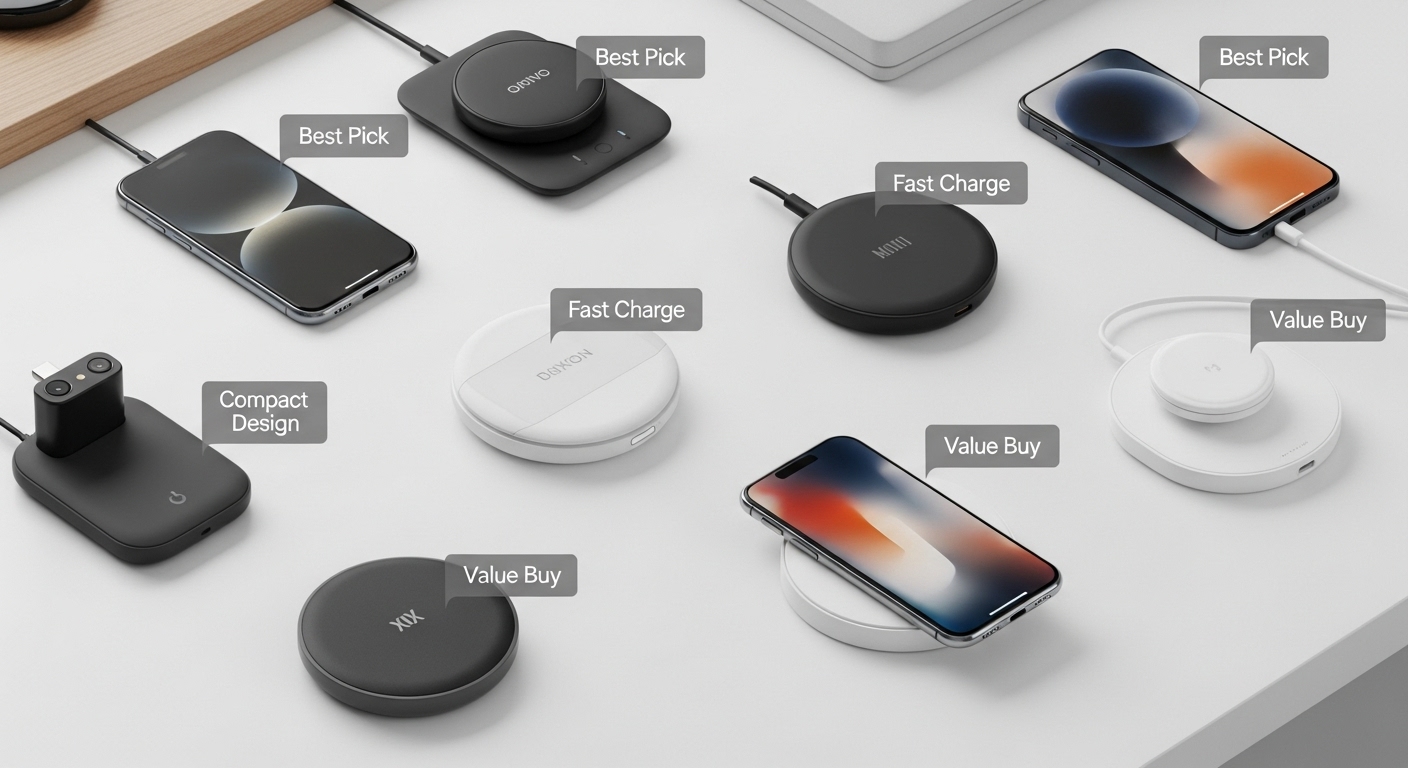The world of technology has been evolving rapidly, and one of the most noticeable changes in the way we use our devices is the move towards wireless solutions. Among the most useful innovations in recent years is wireless charging. Gone are the days of fumbling with tangled cables or worrying about frayed wires. Instead, wireless chargers have made it possible to power up smartphones, earbuds, and even smartwatches with a simple placement on a charging pad or stand.
As the demand for convenience continues to grow, wireless chargers have become an essential accessory for many households and workplaces. From fast charging pads to sleek stands that double as desk organizers, the market is full of options that cater to different needs and budgets. Reviewing the best wireless chargers provides insight into how each design meets the demands of users, the features that set them apart, and how they contribute to a smoother and more efficient lifestyle.
The Evolution of Wireless Charging
Wireless charging technology has its roots in the concept of electromagnetic induction, which dates back over a century. However, it only gained mainstream adoption in the last decade as smartphones began integrating wireless charging capabilities. The introduction of standards like Qi made it possible for chargers and devices from different manufacturers to be compatible with one another. This level of standardization was a game changer, ensuring that users did not have to rely on proprietary systems or brand-specific chargers.
As the technology matured, wireless chargers moved from being simple charging pads to more advanced accessories capable of delivering fast charging speeds. Some even allow multiple devices to be charged simultaneously, reducing clutter and making it easier for families or professionals to keep all their gadgets powered throughout the day.
Factors That Define the Best Wireless Chargers
When reviewing the best wireless chargers, several factors must be taken into account. Charging speed is one of the most important considerations. Modern devices support fast charging, and the best wireless chargers are designed to deliver power at higher wattages without overheating or damaging the battery.
Design also plays a major role. Some users prefer flat charging pads that can sit discreetly on a nightstand, while others prefer angled stands that allow them to view notifications and use their device while it charges. Durability, portability, and build quality all contribute to the overall value of a wireless charger.
Compatibility is another critical aspect. While most chargers now support Qi-enabled devices, there are differences in how well they work with specific brands. Chargers that offer adaptive charging for both Android and iOS devices tend to stand out. Additionally, safety features such as temperature control, foreign object detection, and surge protection ensure that devices remain safe while charging.
Premium Wireless Chargers
At the top of the market, premium wireless chargers distinguish themselves through sleek designs, fast charging speeds, and advanced features. These chargers are built for users who value both style and functionality. Premium models often use high-quality materials such as aluminum or glass, giving them a sophisticated appearance that blends seamlessly into modern home or office environments.
One of the hallmarks of premium wireless chargers is their ability to deliver consistent fast charging speeds. They are designed with advanced heat dissipation systems to prevent overheating, allowing users to charge their phones quickly without concern. Many premium models also include multiple coils, ensuring that devices begin charging as soon as they are placed on the pad, even if not perfectly aligned.
Mid-Range Wireless Chargers
Mid-range wireless chargers strike a balance between affordability and performance. They provide reliable charging speeds and decent designs without commanding the price tag of premium models. Many of these chargers come in compact sizes, making them suitable for travel or small spaces.
Some mid-range models include features such as dual charging zones, allowing users to charge both a smartphone and wireless earbuds simultaneously. Others are designed as stands with ergonomic angles, making them convenient for video calls or watching media while charging. These chargers tend to prioritize practicality, appealing to users who want efficient charging solutions without unnecessary frills.
Budget-Friendly Wireless Chargers
For users who are primarily looking for convenience at the lowest possible cost, budget-friendly wireless chargers are a practical solution. These chargers are generally slower than premium or mid-range options, but they get the job done for overnight charging or light daily use.
While budget chargers may lack advanced features such as multiple coils or ultra-fast charging, many still come with safety certifications that ensure reliable performance. Their affordability makes them attractive for households that want multiple chargers scattered across different rooms, ensuring easy access to wireless charging anywhere in the home.
Multi-Device Wireless Chargers
With the growing number of gadgets people carry—smartphones, wireless earbuds, and smartwatches—the need for multi-device chargers has grown significantly. Multi-device wireless chargers are designed to handle several devices at once, reducing clutter and eliminating the need for multiple charging cables.
Some of the best multi-device chargers are designed with dedicated charging areas for each type of device. For instance, a flat section may be designated for a smartphone, while a smaller pad is reserved for earbuds, and an angled stand holds a smartwatch. This organization not only makes charging more convenient but also creates a clean and minimalistic setup.
Multi-device chargers are especially popular among families or professionals who use multiple devices daily. The convenience of being able to place all devices on a single pad at night and wake up to fully charged gadgets cannot be overstated.
Portable Wireless Chargers
Portability is another key feature that has driven innovation in wireless charging. Portable wireless chargers combine the functionality of a power bank with the convenience of wireless charging. They allow users to charge devices on the go without needing access to a wall outlet.
These chargers are especially useful for frequent travelers, outdoor enthusiasts, or professionals who spend long hours away from traditional power sources. Some portable models also include wired charging options, giving users greater flexibility in managing their devices.
When reviewing portable wireless chargers, battery capacity, charging speed, and size are crucial factors. The best models strike a balance between being lightweight enough to carry comfortably and powerful enough to recharge devices multiple times.
Wireless Charging Stands
For those who spend long hours at a desk or who want to keep their devices visible while charging, wireless charging stands are a popular option. Unlike flat charging pads, stands hold the phone upright at an angle, allowing users to see notifications, participate in video calls, or stream content while charging.
Many stands are designed with adjustable angles, ensuring ergonomic comfort during use. They are often favored by professionals who want their workspace to remain organized and functional. Some even feature additional USB ports, providing versatility for charging non-wireless devices at the same time.
Wireless Charging Pads
On the other hand, wireless charging pads are favored for their simplicity and versatility. They are typically smaller and flatter, making them easy to place on nightstands, coffee tables, or office desks. Pads are convenient for those who prefer to place their devices down without worrying about precise alignment or positioning.
Pads are also more portable than stands, and many can be easily slipped into a bag for use in hotels or offices. They may not offer the visibility of stands, but their minimalist design appeals to users who prioritize practicality and ease of use.
The Role of Safety in Wireless Charging
An important part of reviewing wireless chargers is assessing their safety features. With the flow of electricity happening wirelessly, safety mechanisms are essential to protect both the charger and the device being powered.
The best chargers incorporate foreign object detection, which ensures that coins, keys, or other metallic items do not cause overheating or pose risks when mistakenly placed on the charging pad. Temperature control mechanisms help maintain a steady charging environment, preventing damage to device batteries. Additionally, surge protection ensures that sudden power fluctuations do not harm sensitive electronics.
The Impact of Wireless Charging on Daily Life
Wireless charging has become more than just a convenience—it has changed how people interact with their devices. It encourages a more organized lifestyle, reducing the mess of cables and adapters. In offices, wireless charging stations have become common in conference rooms, allowing multiple participants to charge their devices during meetings. In homes, they create a seamless charging experience, where family members can share charging pads without worrying about cable compatibility.
The integration of wireless charging into furniture, vehicles, and public spaces highlights its growing role in everyday life. From coffee shops offering charging tables to cars with built-in charging pads, the technology has moved beyond being a personal accessory to becoming part of public infrastructure.
Future of Wireless Charging
Looking ahead, wireless charging is expected to become even more advanced. Researchers and companies are working on long-range wireless charging, which would allow devices to charge without needing to be placed directly on a pad. This could enable entire rooms to function as charging zones, where devices recharge automatically in the background.
Faster charging speeds and improved efficiency are also on the horizon. As battery technology evolves, wireless charging will likely keep pace, offering the same performance levels as traditional wired chargers. Additionally, sustainability will play a bigger role, with eco-friendly materials and energy-efficient designs becoming standard.
Conclusion
Reviewing the best wireless chargers reveals just how much the technology has evolved and how significantly it impacts modern life. From premium models that combine speed with elegant designs, to budget-friendly options that make wireless charging accessible to everyone, there is a charger to meet every need. Multi-device chargers cater to families and professionals with multiple gadgets, while portable models bring wireless charging on the go. Stands and pads each offer unique advantages, ensuring users can choose based on their lifestyle preferences.
Wireless charging has not only made powering devices easier but has also created a culture of convenience and efficiency. As the technology continues to advance, it will likely become an invisible yet indispensable part of daily life. The best wireless chargers today are more than just accessories—they are the foundation for the wireless future that is unfolding before us.


